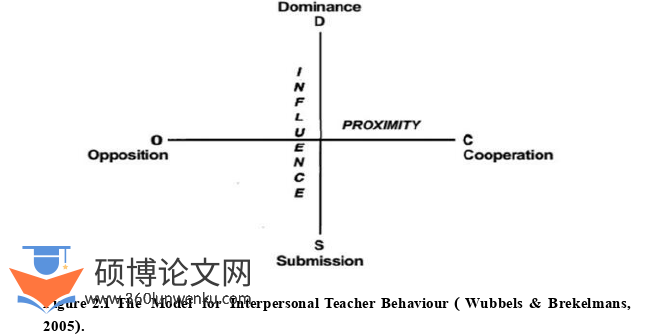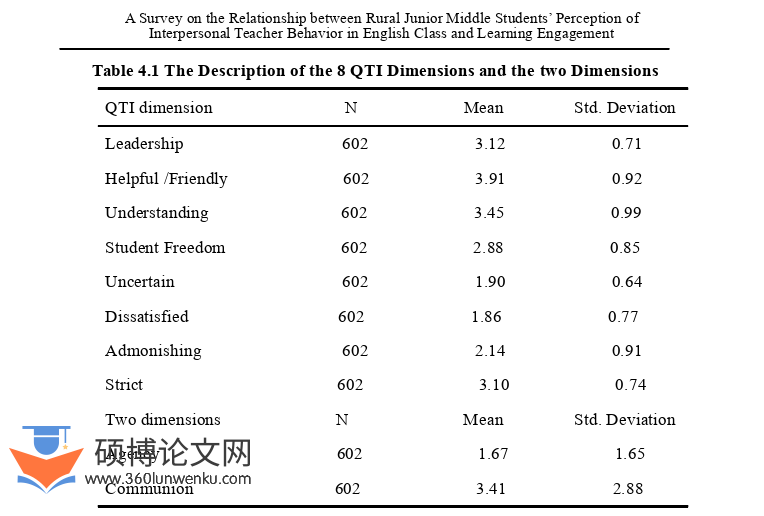本文是一篇英语论文,本研究主要围绕以下问题展开:(1)农村初中英语课堂中学生对教师人际行为的感知现状如何?不同性别、不同年级的学生在感知教师人际行为方面有何差异?(2)农村初中英语课堂中学生的学习投入现状如何?不同性别、不同年级的学生在学习投入方面有何差异?(3)农村初中英语课堂中学生对教师人际行为的感知与他们英语学习投入的关系如何?
Chapter 1 Introduction
1.1 Background of the Study
In the process of implementing quality education,the topic of teacher qualityhas been increasingly valued.Teacher behavior,as a kind of external form ofteacher quality,played a crucial part in teaching effectiveness and studentdevelopment(Liu Guizhen,Xin Ziqiang,Chi Liping,2005).Xin Ziqiang,LinChongde,and Yu Guoliang(2000)stated that interpersonal teacher behavior(hereafter ITB)referred to the teaching behavior exhibited by teachers in theprocess of teacher-student interaction.To some extent,the nature ofteacher-student relationship is determined by the teacher’s behavior.Furthermore,teacher’s proper interpersonal skill and behavior could create a favorableenvironment for students’development.Based on 35 years of research onteacher-student relationship,Wubbels(2000)introduced the interpersonalrelationship diagnosis model into teaching,transformed it into a model forinterpersonal teacher behavior(MITB)with the dimensions of influence andproximity,and then developed a teacher interaction questionnaire based on thismodel.
Wubbels was the former president of the European Association forEducational Research and a professor at the University of Utrecht in theNetherlands.Based on interpersonal relationship theory,he studied interpersonaland interactive behavior between teachers and students from the perspective ofinterpersonal relationships.The classroom is the important place whereteacher-student communication occurs,and Wubbels et al.(2000)believed that theclassroom should be seen as a mini social system composed of each behaviorperformed by teachers and students.Similarly,the English classroom can also beconsidered as a tiny social place for teacher-student interaction.
............................
1.2 Purpose and Significance of the Study
The main purpose of this study is to investigate the association between juniormiddle school students’perception of ITB and their English learning engagementincluding emotional engagement,behavioral engagement and cognitive engagementbased on the rural context.This study is necessary and significant because itcontributes to the body of knowledge needed to address the problem of juniormiddle school students’inadequate and unbalanced engagement in English learningand its relationship with students’different perceptions of ITB.Therefore,understanding students’different perceptions of ITB will provide educators withvaluable information that can be used to improve teaching and learning.
From the perspective of theoretical significance,this study provides a basis formore studies of students’perception of ITB and students’learning engagement inrural context.The overall current state of students’perception of ITB and students’learning engagement will be analyzed in different grades and genders.With theinterpersonal behavior theory and dynamic systems theory as the theoretical basis,the impact of students’perception of ITB on their learning engagement in Englishwill be presented and explained in the study.
................................
Chapter 2 Literature Review
2.1 Interpersonal Teacher Behavior(ITB)
Xin Ziqiang el al.,(2000)held a belief that“ITB was one kind of teachingbehavior,which could be shown by the teacher in the process of interaction withstudents”.At present,there are three main perspectives on ITB or teachers’behavior(Wubbels et al.,1995;Rickards,Tony&Fisher,Darrell,2000):the firstis the perspective of contents,focusing on the meaning of teachers’speech andactions.The second is to conduct research on specific teaching behaviors such asteaching,guidance and strategic levels from the perspective of teaching methods.The third is that the teacher behavior is regarded as the interpersonal interactionbetween teachers and students that creates and maintains a working atmosphere inthe classroom.Wubbels et al.(1995;Rickards,Tony&Fisher,Darrell,2000)believed these three perspectives could be applied to the study of every situation ofteacher behavior.However,in more contexts,it is more important to study ITBthan any other perspective from the perspective of interpersonal communication,for the reason that students’engagement in learning can be better promoted by theITB,which has been investigated and confirmed by Ellen A.Skinner and Michael J.Belmont(1993).In view of this,this study mainly studied the association betweenstudents’perception of ITB and their learning engagement.

英语论文怎么写
.........................
2.2 Learning Engagement
Learning engagement is the core concept of educational psychology and animportant topic in the field of educational research.It can examine students’learning achievement,predict students’learning performance and evaluate teachers’teaching effectiveness.The initial concept of learning engagement was put forth bySchaufeli(2002),who further expanded his investigation to encompass students.He suggested that learning engagement mirrored work engagement,signifying afavorable cognitive state associated with acquiring knowledge,comprising threedimensions:vitality,dedication and focus.(Schaufeli et al.,2002),among whichvitality referred to learners who had great energy and resilience and were willing towork hard for learning without fatigue when faced with difficulties;Dedicationentailed individuals possessing a profound sense of significance,admiration,and anintense enthusiasm for acquiring knowledge,enabling them to wholeheartedlydedicate themselves to learning and fearlessly confront challenges;Focus denoted astate of enjoyment,wherein one concentrated on learning and encountered a feelingof gratification.However,Kuh et al.(2016)thought that learning engagementreferred to the time and energy invested by students in learning activities,as well asthe efforts put into teaching practice.Researchers have presented their different views on the dimensions of learning engagement,in which Fredricks’(2004)three-dimensional model has been widely recognized and applied.In his opinion,students’learning engagement consisted of three scales:emotional engagement,behavioral engagement and cognitive engagement.For behavioral engagement,itincludes effort,persistence,focuses and so on;cognitive engagement includespositive investment and learning strategies;emotional engagement includes interest,boredom,anxiety etc.Fredricks’(2004)classification of learning engagement wasalso adopted in this study,which consisted of emotional engagement,cognitiveengagement and behavioral engagement.
..............................
Chapter 3 Research Methodology........................33
3.1 Research Questions..............................33
3.2 Participants....................................33
3.3 Instrument...............................34
Chapter 4 Results and Discussion..............................41
4.1 Students’Perceptions of ITB............................41
4.1.1 Students’General Perceptions of ITB............................41
4.1.2 Gender Difference in Students’Perceptions of ITB......................49
Chapter 5 Conclusion..........................70
5.1 Major Findings...................................70
5.2 Implication..................................71
Chapter 4 Results and Discussion
4.1 Students’Perceptions of ITB
In this part,the results of students’current perceptions of ITB corresponding tothe first research question will be displayed followed by the discussion afterconducting questionnaire and interview.The results of gender differences and gradedifferences in students’perceptions of ITB will be shown as well with thesubsequent discussion.
4.1.1 Students’General Perceptions of ITB
Results:By processing the data,the descriptive information about ITB wasobtained from SPSS.Mean score and standard deviations of the QTI dimensionsand the two dimensions were shown in Table 4.1.It shows that the mean scores inLeadership,Helpful/Friendly,Understanding and Student Freedom dimensions areall above 2.50,higher than those of Uncertain,Dissatisfied and Admonishingbehaviors with exception of Strict behavior whose value is above 3.00.Hence,students perceive more positive and cooperative ITBs.With respect to the twodimensions,the mean score of Communion dimension is 3.41 higher than that ofAgency dimension which is 1.67.The results can be seen below.

英语论文参考
......................................
Chapter 5 Conclusion
5.1 Major Findings
This study examined the association between how students perceive theirteachers’interpersonal behavior and their level of engagement in learning in a ruraljunior middle school in China.It offers additional evidence to support previousstudies that have utilized the QTI within the Chinese context.And using Learningengagement questionnaire to measure students’learning engagement in English,thisstudy can be supportive for further research regarding students’learningengagement from the perspective of interpersonal behavior theory and dynamicsystems theory in rural areas.The major findings are as following:
Firstly,students in rural junior middle school perceive more cooperativeinterpersonal behaviors than dominant interpersonal behaviors from their Englishteachers in class.Male students have a less favorable perception of ITB comparedto female students.And students in Grade 9 perceive more positive perceptions ofITB than students in Grade 8 and Grade 7.
Secondly,concerning students’learning engagement in English,students inrural junior middle school have shown some higher emotional engagement inEnglish compared to their behavioral and cognitive engagement.Girls invest morein emotional engagement than boys do,hence,girls can perceive more ITB apartfrom teachers’dissatisfied and admonishing behaviors.Thus,boys perceive theirteachers as more dissatisfied and admonishing than girls.However,there are nosignificant differences in teacher Dissatisfied behavior and Strict behavior amongstudents in different grades.
reference(omitted)
